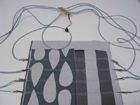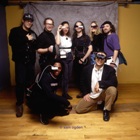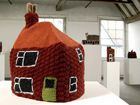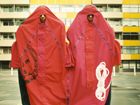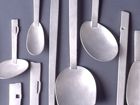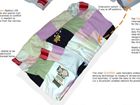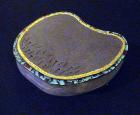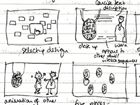Sarah Kettley Abstract This article takes the concept of ambiguity as presented by Gaver, Beaver & Benford [1] as a tool to discuss what has been described as ‘undecidables' - conceptual art works in the domain of the wearable, which currently find themselves crossing the usual framing mechanisms of art, craft and design [2]. How practitioners choose to frame their work has implications for its interpretation. The physical object has a presence that can be hard to escape; it presents a reality already in existence, even as it suggests a possible future, and may even disallow the space between "looking at the work, and the prospect of using it" [3]. Some of the tactics used by conceptual practitioners in interaction design and contemporary craft to get around this problem are illustrated with a view to expanding the tactics for ambiguity offered by Gaver et al's original paper [1].
Background to ambiguity
The primacy of explicit information in interaction design and HCI, which Richard Coyne identified as only one of several possible approaches to computational media [4], has recently been joined by rigorously argued cases for alternative and complementary methodologies and end goals. These include Coyne's own framework of conservative, pragmatic, critical and radical approaches [4]; the investigation of seamfulness, as opposed to Mark Weiser's seamlessness, by researchers at Glasgow University [5]; the "rhythm of reflection and transparency" advocated by Bolter & Gromala [6], and of course, the concept of ambiguity as presented in Gaver et al's 2003 paper at CHI [1]. Here the author concentrates on ambiguity, revisiting conceptual wearable works to identify at which point ambiguity might reside, and to consider the ramifications for interpretation of the mode of these works' delivery.
What is ambiguity?
Occurring at different points in the interpretive relationship between viewer and object, ambiguity is shown to be an important resource for interaction design and HCI [1]. The framework suggests three different types of ambiguity: of information, in which a visual output, normally explicit, is blurred or scrambled; of context, in which a recognisable object with strong connotations is replaced within a new context, thus highlighting how we read objects through their framing; and of relationship, in which the viewer is asked to imagine their own extended interaction with the work in some way. For good physical examples of these types of ambiguity, the reader should reference the original paper [1]. This article extends the tactics for using ambiguity to include consideration of the mode of presentation, with its implications for the interpretive space.
Ambiguity and the interpretive gap - some issues
Practitioners often choose not to implement possible technological concept designs, but rather to present them say, as photography, prototypes, ‘genotypes', or installations. Anthony Dunne's Hertzian Tales deals directly with this issue: the "apparent unusability" of his objects "creates a heightened sense of ‘distance'. This can be because the objects do not work technically, or preferably, because they are conceptually difficult to assimilate (figure 1). Through use, or at least by modelling a scenario of use in the mind, the observer finds new ways of conceptualising reality" [3]. In the chapter "PsychoSocial Narratives", Dunne looks at some of the ways narrative spaces around the technological object can be presented, including through media such as film, the novel, performance, music and soundscape, visual imagery, and of course, the object. How and where the designed object is presented to the viewer constitutes much of its meaning in culturally framing it, and indeed, is at the heart of Gaver et al's identification of ambiguity of context, which they illustrate using Duchamp's Fountain - sculpture or urinal depending on where, and by whom, it is viewed [1]. Dunne identified the problem with working prototypes as being that they do not challenge assumptions - instead merely presenting a view of an improved reality - and saw this as a problem with some of his own earlier work [3]. The imaginative interpretive gap is closed by their insistent existence. If temporal designs (which interactive objects or systems must be) are presented within a gallery environment, they must also contend with existing art movements and visitors' expectations resulting from them. There is a tendency to the passive spectacle, which creates problems with rates of feedback in these systems - where a system has been designed to give subtle interactive feedback, experienced over time, it can fail in this kind of environment. The author has experienced this problem herself, with the demonstration of a group of socially interactive jewellery pieces (figure 15), intended to map and thus possibly alter, social interaction patterns and motivations over prolonged use [7]. In demonstration, it was found that the rates of visual output patterns had to be substantially speeded up in order to hold the attention of viewers before they began to engage with the concepts behind the work, which in turn meant a higher level of explanation was needed to present the concept as intended - thus, of course, closing the interpretive gap again. Solutions to these problems may include using film, in which time can be manipulated, and in placing designs in longitudinal use situations.
Ambiguous approaches to the wearable artifact
Taking the three loci of ambiguity, examples are given from wearables practice, and their modes of presentation described.
Ambiguity of information is the motivation behind the woven textile work of researchers at the Play Research Studio, Sweden [8]. Treating computational artifacts as design materials, they seek to ‘re-interpret elementary acts of information technology use’, and to focus on such expressive qualities as vagueness and unpredictability [8]. Using heat responsive threads and inks, woven and printed textiles can be constructed to have three layers of semiotic meaning – the first static in the standard construction of the textile, the next a dynamic woven layer, and the third a responsive ink based display. A single textile piece can thus give multi-layered dynamic information, and the granularity of spatial and temporal resolution can be controlled to create ‘slow’ technology with rich, blurry information (figure 2). The group typically develops working demonstration pieces for art museum installation, and tests the work in the design studio with other practitioners, presenting the theoretical approach and technological issues and findings through dedicated conferences. The physical realization of the work is as integral to its nature as its concept, and museum visitors’ and colleagues’ engagement with the pieces are recorded for critical discourse.
Jayne Wallace is a jeweller working at the intersection of contemporary craft and HCI. Her digital pendant acts as a personal container of memories, using the methodology of cultural probes and presenting the finished non-implemented physical piece as a prop within a short narrative video [9]. Ambiguity is encouraged through the use of intermittently available messaging technology, so that images significant to the wearer appear ‘only sometimes’ on locally available surfaces (figures 3-5). The use of video makes clear the working of the piece, allowing the viewer to imagine how it may fit into their own lives; moreover, the production style of the video itself serves to extend and unite the fragmented, delicate expression of the jewellery and interaction.
Ambiguity of context occurs in more than one way in wearables. It may be apparent in the treatment of the body itself as site for commentary, or may occur in the mode of presentation of wearable concepts. The forms of functional wearable computing developed by companies such as Xybernaut [10] and Charmed [11], are commercial products, but the irony of wearable computing as a domain is that it is radical already. The narrative of the cyborg has gained such cultural currency that the original research ‘borgs’ at for example MIT, have themselves created a barrier to a social appropriation of their technological advances (figure 6) [12]. So attempts at crossing the ‘last frontier’ [13] of the everyday for wearables often appear provocative in the manner of conceptual art, and the viewer of its promotional material consequently feels free to question its validity as a social paradigm.
Metalsmith Ira Sherman makes beautifully articulated mechanical body pieces with well-defined social functions. The Arbitrator, for example, sits over the head and shoulders of two protagonists, and is released only when they have reached agreement [14]. The ambiguity of context occurs in the aggressively mechanistic aesthetic employed by Sherman contrasted with the vulnerability of its human inhabitants (figure 7). Jeweller Norman Cherry, meanwhile, currently presents on the theme of the feasible and imminent practice of angiogenetic body adornment – the growing of human skin, bone and cartilage for aesthetic reasons [15]. Disseminated through academic channels, the realism of the Photoshop-ed designs is compelling in this context (figure 8). There is also a strong element of ambiguity of relationship at play in both these works, which results from both their aesthetic and their function.
Ambiguity of relationship is evident in the work of Freddie Robbins and Lucy Orta, but the work is framed in different ways. Robbins’ conceptual knitwear is presented in a gallery environment, and plays on the gallery’s remove from the everyday world in order to increase the impact on the viewer when their assumptions, based on historical and gender roles of the material and process of knitting, are inverted [16]. Thus, in ‘Knitted Homes of Crime’, the comfortable iconography of the home is presented through the non-threatening medium of the knitted tea-cosy (figure 9). Initially friendly and funny, these ‘immediately lose their appeal once you know what they represent’, i.e., the homes of female murderers [16]. The visitor to the art gallery space is largely unsuspecting until they engage with the texts that accompany the exhibition, in the form of wall-mounted information, catalogues, or through interaction with a member of staff. Robbins deftly manipulates materials and processes with inherent cultural identities to introduce ambiguity at the point of relationship. Her series of gloves, meanwhile, play on the normative experience we take for granted of the hand, and its translation into a given form of clothing. In doing so, Robbins presents us with more or less digits than expected, or shows us stigmata and burnt fingers [17]. The pieces remain ambiguous in their unwearability, provoking questions regarding our perception of normality, rather than of how they might fit into a viewer’s own reality. Lucy Orta, another textile artist, creates politically motivated dwellings that blur the boundaries between functionally personal clothing and social spaces for survival. Her work is documented in public events in which volunteers inhabit the structures, and interact with them [18]. The pieces are usually presented as animated with life through these performances, and subsequently re-presented in photography and video (figure 10). In Orta’s case, a possible reality is made explicit, but like the Bais-ô-Drôme by Van Lieshout in Gaver et al’s paper [1], the circumstances under which we might want to inhabit it are challenging.
The works of interaction designer Anthony Dunne and of jeweller Hazel White also exhibit ambiguity of relationship; Dunne’s ‘Thief of Affections’ is a suggestive mobile object with a close relationship to the body, and is carried by the user, identified as ‘an obsessive individual’ who craves human intimacy (figure 11) [3]. Eventually presented as a prop within a series of photographs with their own overtones of anthropology and medical imagery, the experience of the design is extended by Dunne’s consideration of possible packaging (a shoe box, marked S, M or L), and of the feedback sounds the object might give (vaguely masculine to vaguely feminine) [3]. Wallace and Dunne both create finished objects, which are then placed within a narrative presentation. Hazel White’s work, in contrast, consists of the narrative presentation. White describes herself as a jeweller, whose ‘body interventions’ series has been exhibited as art in galleries, as design in museums, and discussed as craft, uses material props in photographs, again with their own powerful aesthetic (figure 12). In these works, there is a visible element of impossibility – objects appear to be situated in relation with internal organs, or aesthetically challenging elements are arranged over the naked body [2]. Although White crafts these elements herself, at no point is there any suggestion of them constituting the final object in their own right. Instead, the final outcome is the image, or the ‘undecidable’ form of narrative artwork. As in Wallace’s work above, the expression of the presentation employed by these practitioners is intimately bound up with and supportive of the expression of the work as a whole.
Contemporary craft for ambiguous design
Contemporary craft is a form of art in its presentation of experience. It has a history of manipulating rhythms of transparency and reflection that may provide a resource for interaction design and HCI because, as a field of design, it too has utilitarian foundations, which have been overtaken by poetic motivations. The discipline of ceramics for example, has an ongoing obsession with the form of the vessel, and the change in perception of the viewer/user as the context of the object changes, not only from gallery to domestic environment, but at a micro level, from shelf to table, from placemat, to hand, to mouth [19]. Contemporary craft is differentiated from traditional practices in its interest in the expressive potential of materials rather than in the ability of materials to display wealth. So we see the appropriation of ‘pavement art’ in ‘pavement jewellery’, the use of found objects in all areas, and the employment of ‘unfinished’ edges in silversmithing (figure 13) [20], [21]. Contemporary craft is also being dynamically redefined in practitioners’ use of technologies such as computer aided design and rapid prototyping, wherein the prototype often becomes the final object [22]. What remains, as in Anthony Dunne’s definition of the designer, is authorship of an experience, and what differentiates it from design, is the metaphorical nature of that authorship within the crafted object [23], [24], [25]. This metaphorical aspect turns authorship itself into a narrative, added to the other narratives to be found in the concept and form of the piece. Seamlessness and seamfulness, transparency and reflection, and usefulness, usability and ambiguity, can be traced in the history of craft practice as much as in our conceptualization of technology for society. Where the silversmith once delivered flawless polished finishes, he may now choose to draw attention to the making process through the use of contrasting solders. Where once virtuoso making was revered for its own sake, now it is seen as self-aggrandizing, an empty gesture without humility. The metaphor of the craftsperson is that of humanity, and the ambiguity of the contemporary craft object rests in its making physical human imperfection [24]. The intriguing imperfection of the craft object in turn offers a space for empathy, and for agentive interpretation, the rich ambiguity of meaning that rewards repeated visitation. Thus, contemporary craft is a strong candidate as a tactic for overcoming some of the problems of ‘distance’ in opening ambiguous interpretation up to the viewer, because it allows familiarity and newness to coexist within the same form. There are issues with this approach, however, especially when the differentiation between traditional and contemporary craft is not considered carefully enough. The ComfortBlanket, by the author, suffered from this, and although it could be said to have been crafted, in that it was a patchwork blanket made individually, it was not a piece of contemporary craft with all the metaphor and ambiguity that that brings, because it did not take into account, for example, the historical meanings of the patchwork tradition, nor did it act to present an experience other than that of a narrow, received notion what ‘craft’ stands for in a technological world (figure 14) [7]. It is essential, therefore, to be aware of a wider perception of ‘craft’ when approaching this method.
Tactics for framing ambiguity
The examples above have been chosen to try and illustrate some of the ways in which ambiguity in wearable design might be framed through the mode of representation. With more than a nod to Gaver et al [1], these tactics for framing are neither exhaustive, nor exclusive. Instead the author hopes they spark ideas for the creative dissemination of ambiguous design work. Neither are these tactics specific to the wearable genre, of course, and a deeper analysis of the links between genre and framing device may offer a fruitful avenue for further research.
Ambiguity of information - It can be seen from these examples that in conceptual interaction design, where many issues revolve around temporal experience of the output, temporally based tactics are correspondingly useful. That is, those forms in which narrative is particularly strong, such as film or creative writing, installation and performance. The nature of these representations in turn is important; they should embody the same expressions as the forms and interactions they present. Further, do they prescribe use, or do they themselves embody a further ambiguity of use? The user manual, for example, has an interesting aesthetic of its own and is a form of temporal narrative, but stands as an extreme case of prescription (and thus also proscription).
Ambiguity of context is most strongly associated with the channel of dissemination – whether the concept is presented in an art gallery, shopping center, or at an academic conference – and also in its relation to the human actor. We have seen above that mechanistic aesthetics have been used both knowingly and unwittingly to challenge the idea of computational products for the body. Product packaging, point of sale and advertising also play important roles in interpretation of products, and should be explored for more conceptual ends. In wearables, the body may serve as the most obvious site of ambiguity, either in one to one relationship with the object, or in social interaction where the public and private realms can be inverted and merged.
An ambiguity of relationship is facilitated by an element of familiarity in the work, seducing the viewer up until the point they realize what appropriation of the reality presented might actually mean. Thus, craft can be used for its familiar connotations, as in the knitted pieces of Freddie Robbins, while also posing provocative questions. While bearing in mind the problems mentioned above, in crossing the boundaries of interpretive appropriation craft can thus play an invaluable role. Anthony Dunne points to the possibility of placing, not one-offs, but series of batch produced working prototypes within a gallery environment, to create ambiguity both of context and relationship: ‘the gallery becomes a ‘showroom’, allowing them to enter everyday life through the marketplace, a specialist shop selling materialist culture, trading in shock-of-the-new re-interpretations of familiar objects’ [3]. Contemporary craft would suit this tactic very well, with its interest in rapid prototyping as a medium, and the craft gallery itself would in turn be interestingly reframed.
Conclusion
The author is part way through a project producing a range of conceptual smart jewellery, which exhibits most strongly an ambiguity of relationship. The goal of the presentation approaches of this work is to facilitate an ambiguity of relationship through the co-presence of elements of familiarity, both in the craft techniques used to fabricate the work, and in the use of presentation techniques to explain its basic interactive nature. The viewer, as prospective wearer, should be able to understand the interactive nature of the jewellery easily enough to then extrapolate its possible meanings for themselves within a larger social environment. As products aimed at a contemporary crafts market (figure 15), these pieces have the potential to be individually made or produced in small batches, as proposed by Dunne above, making use of the familiarity of the market place, and usurping it in turn. It is in this seduction that the work’s potentially critical role is made possible; through consumer acceptance and appropriation, attention will be drawn to the delicate process of social interaction, an attention which in turn has the ability to both create and destroy these processes in new ways. The jewellery does this by identifying the proximity of other wearers as being intimate (below 30cm), social (30cm - 1metre), or distant (above 1metre). It then displays a visual pattern dependent on a combination of this distance with the identity of the individual it has detected. A visualisation of the meeting is thus created, and a trace of it left after the individuals have parted. Further concepts include an accumulative version, which would entail user groups dynamically learning subtle visual clues to interpret the increasingly ambiguous information made available. In this way, the normally veiled is made visible.
There are two possible embodiments of the conceptual work – the portfolio, and the exhibit. While the power of Hazel White’s work resides in its visual expression, the power of this jewellery resides in its actual use after being taken home by the user. The use of photographs, powerful in White’s ‘undecidables’, and in Anthony Dunne’s Thief of Affections, is not appropriate for this particular project. There are three major reasons for this: firstly, the interaction is not one-to-one, or solely between user and device, but based within a multi-user, complex and dynamic social space, which resists simple representation; secondly, the jewellery is, or at least has the potential to be, fully implemented using prototype Speckled Computing technology [26]; and thirdly, the author has a strong interest in the material of the contemporary crafted object, and in the relationship of the wearer with it. Therefore, treating the jewellery as physical rather than visual is far more appropriate to this work. This shifts the nature of the portfolio back towards its more traditional format where it contains, not the work itself as it may in White’s case, but representations of it. However, in this work, the temporal and interactive elements still demand a platform, and so two realizations of the folio are underway – a digitally interactive version to be made available online and on CD (figure 16), making use of animated Social Network Analysis models [27] and the Proce55ing design environment [28]; and a physical paper-based folio, drawing on techniques used in paper prototyping for HCI, on children’s pop-up and lift-the-flap books, and on early moving image experiments by, for example, Edward Muybridge (figure 17). These physical techniques have the advantage of focusing on material interaction, while presenting temporal concepts very simply. They may also form part of the packaging concepts for the work, with flick books serving as ambiguous user manuals.
These approaches to presenting of the work are still being developed, and the article merely puts forward the rationalisation behind them. It is hoped in the meantime that this personal exploration of one designer’s work might serve to highlight some of the issues involved in presentation, and even that it might act as a springboard for inspiration in the work of others in the field of conceptual interaction design.
|


